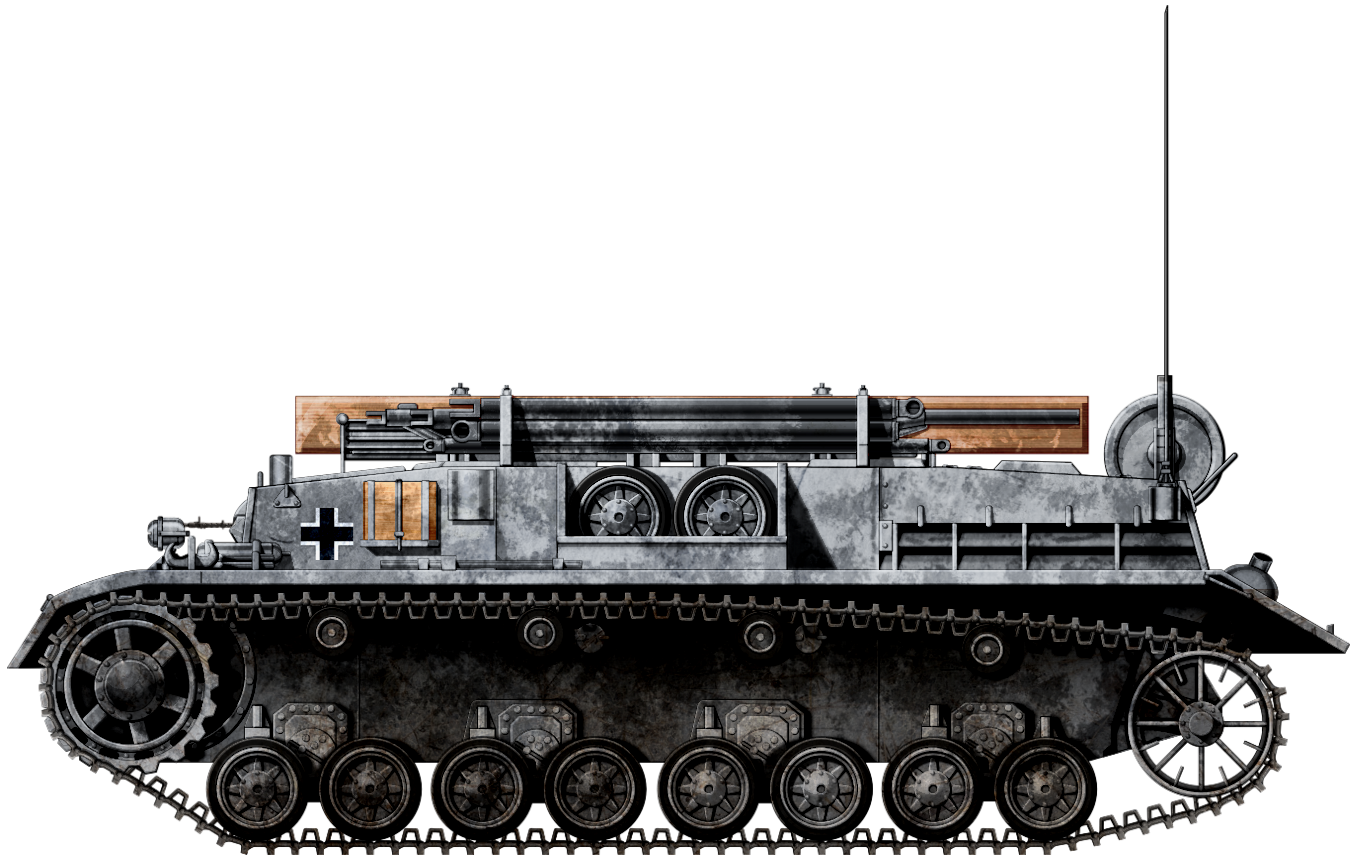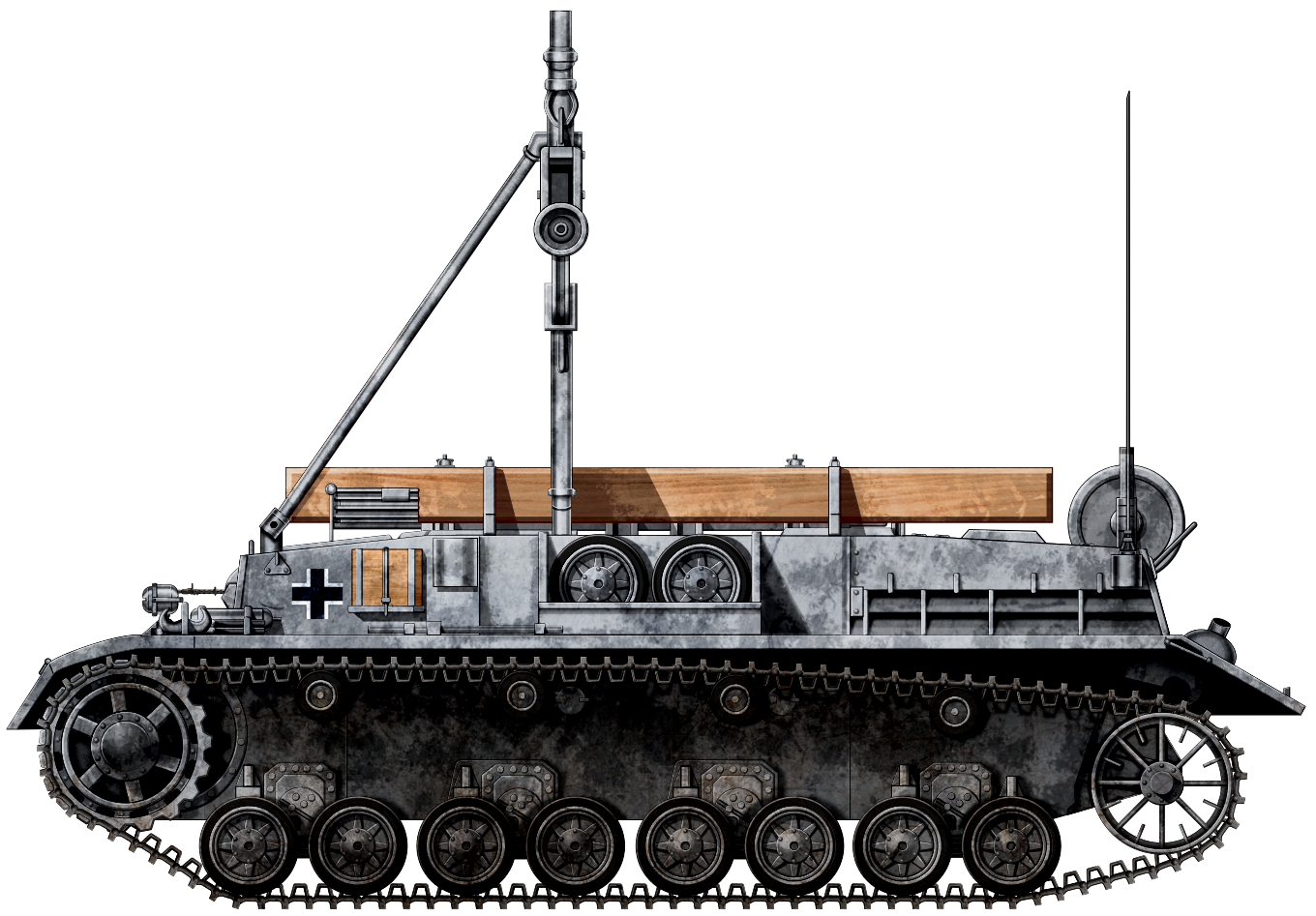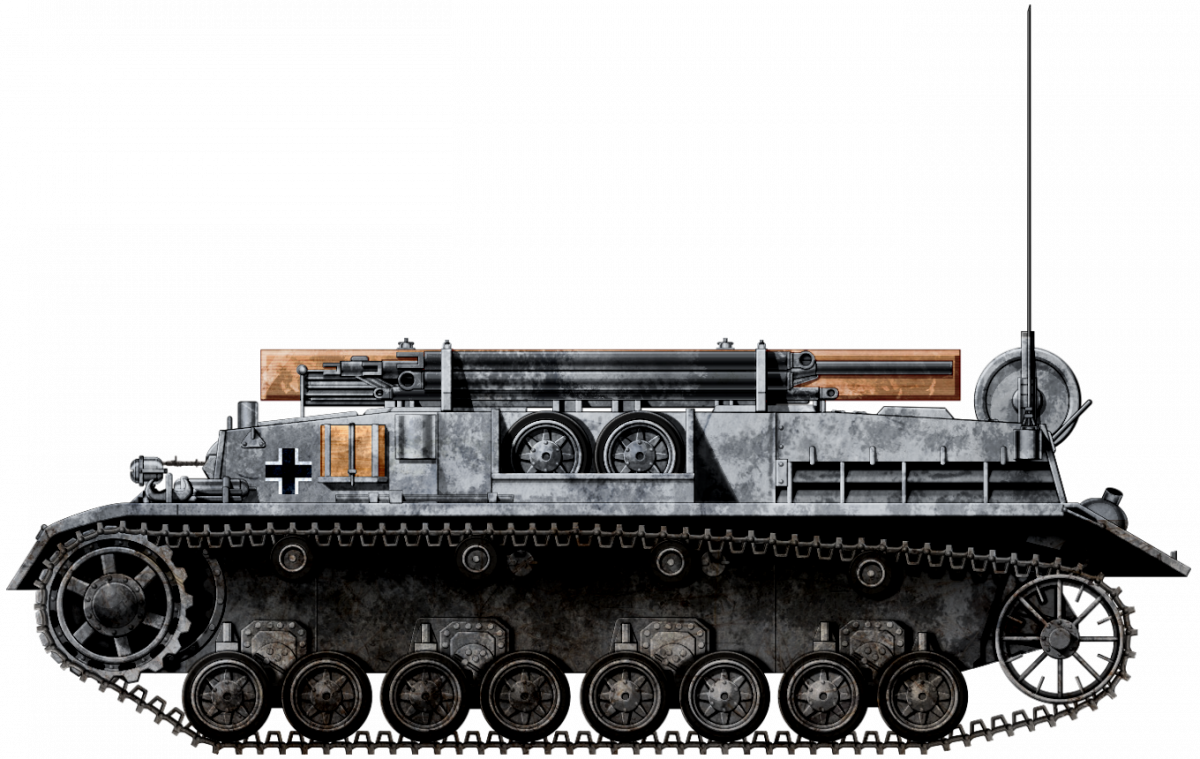 German Reich (1944)
German Reich (1944)
Armored Recovery Vehicle – 21 To 36 Built
Armored vehicles, such as tanks, are designed to withstand enemy fire to a certain extent due to their protection and robust construction. While they can be damaged by enemy hits, this does not always result in complete destruction. Many times, the damage only affects some components or systems, rendering the vehicle temporarily inoperable or immobilized. Such vehicles can be saved from total destruction or at least prevented from being captured by the enemy. This was and still is the job of specialized armored recovery vehicles. During the Second World War, the Germans employed various vehicles for this purpose, and one of them, the Bergepanzer IV, was based on the Panzer IV chassis. This version was built in limited numbers toward the end of the war.

The Panzer IV as a Recovery tank
It is somewhat ironic that an army that heavily centered its offensive capabilities around tanks lacked a dedicated vehicle designed specifically to recover them in case of damage or bogging down. The lack of proper recovery vehicles was a notable issue for the Germans during the war, and it had implications on their ability to recover and repair damaged tanks in the field. The Sd.kfz.9 half-tracks, while useful for some tanks, proved inadequate for the heavier Tiger and Panther tanks, and could not be used in combat situations or under any fire. The lack of proper armor protection for the crew of these recovery vehicles made them vulnerable, limiting their effectiveness. In addition, they lacked the rough terrain mobility that fully tracked vehicles had.
To address this issue, the Germans eventually recognized the need for fully protected recovery vehicles based on tank chassis, which could provide better protection for the crews during recovery operations, even in combat zones. However, due to the demands of the war and the strain on industrial capabilities, the Germans could not spare tanks for this specific purpose in the early stages of the conflict. As the war progressed, especially after 1943, it became evident that dedicated recovery tank designs were necessary. There were two recovery tank designs based on the Panzer III and Panther chassis that were built in some numbers. In addition, there was also a modified Jagdpanzer 38(t) version which was also used in this role.
The decision to convert the Panzer IV chassis for this purpose was made in 1944, during a time when the German military was under tremendous pressure and needed more tanks and anti-tank vehicles. The vehicle was designated as Bergepanzerwagen (Eng. Tank recovery vehicle) IV, but was generally referred to simply as Bergepanzer IV.
However, given the urgent demand for combat-ready vehicles, the conversion and production of the Bergepanzer IV were given relatively low priority. As a result, the number of Bergepanzer IVs produced was limited, making this modification quite rare. Due to the limited production and the chaotic nature of the latter stages of the war, information on the Bergepanzer IV is scarce, and not much is mentioned in the sources about their development history.
Production
In contrast to other Bergepanzers built on the Panzer III and Panther chassis, of which over 500 were built, the Bergepanzer IV’s production was quite limited. How many vehicles were actually completed slightly differs between sources. This discrepancy in the sources clearly shows us how little is actually known about these vehicles
- T. L.Jentz and H. L. Doyle (Panzer Tracts No.16 Bergepanzerwagen) mentioned 21 vehicles being completed from October 1944 up to March 1945
- Walter J. Spielberger (Panzer IV and its Variants) gives a number of 36 vehicles being built.
- T. Jones (The Panzer IV Hitler’s Rock) mentions that the 36 vehicles were built during the period of October to December 1944.
It is important to note that these were not new chassis but were instead converted from Panzer IV Ausf.F to J damaged tanks that were returned from the frontlines. It is also possible the German units on the frontlines made their own ad hoc Bergepanzers based on the Panzer IV.
Given their scarcity, there are no photos of these vehicles. To complicate matters further, identification of these vehicles is not always possible, as the Germans also employed a limited number of Munitionspanzer (Eng. ammunition supply tanks) based on the Panzer IV, and the two versions were visually quite similar.



Design
Chassis
The whole Panzer IV chassis and hull design were mostly unchanged. The front part of the hull housed the transmission, followed by the crew compartment and the engine. One small change was adding a vertical towing coupling to the rear of the hull. It appears that the Germans initially planned to install a winch coupled with a modified transmission to provide power, but this was never done on the Bergepanzer IV. The lack of such equipment severely hindered its effectiveness in the recovery of damaged vehicles.
The suspension was also unchanged. It consisted of eight small double wheels placed on each side, suspended in pairs, and placed on four bogie assemblies. The small road wheels were suspended by leaf-spring units. There were also three to four return rollers (depending on the hull version) on each side. Finally, the drive sprocket was at the front and the idler at the rear.
Superstructure
The superstructure design was also left unchanged. However, given its specialized role, some extra equipment was added. The original turret of the vehicle was not required, so it was removed. The turret opening was covered by a large round-shaped wooden cover. It consisted of wooden planks held together by a steel frame. To provide easy access to the vehicle’s interior, a hatch was added on the right side of the wooden cover. This allowed the crew to enter the storage area within the central part of the superstructure.
On the right side of the superstructure, brackets that held a long wooden beam were added. On the opposite side of the superstructure, a folding 2-tonne jib-boom crane was installed. To assemble it, there were three connection points known as Piltze (Eng. Mushrooms) welded to the superstructure’s top. This feature was actually present on a number of vehicles produced near the end of the war. The idea behind it was that ordinary vehicles (for example, the Jagdpanzer IV or StuG IV) could be used as auxiliary repair vehicles when the engine or other heavier parts needed to be removed for replacement or repair.



Engine
The Bergepanzer IV was powered by a Maybach HL 120 TRM 265 hp@2,600 rpm engine. By removing the turret, armament, and ammunition, and reducing the crew’s size, the weight of the Bergepanzer IV was reduced by approximately five tonnes compared to the standard Panzer IV Ausf.H and J tanks (from 25 to 20 tonnes). The weight reduction allowed the Bergepanzer IV to achieve a maximum speed of 42 km/h, which was slightly higher than the standard Panzer IV’s top speed of 38 km/h.
Regarding its operational range, the Bergepanzer IV could travel up to 210 km on good roads and approximately 130 km off-road. However, it is worth noting that vehicles based on the Panzer IV Ausf.J’s chassis likely had an extended operational range of up to 320 km due to their larger fuel load capacity. This extended range would have provided more flexibility and endurance during recovery and support missions.
Armor
Depending on the Panzer IV chassis used for this modification, the frontal armor thickness ranged between 50 to 80 mm. The side armor was 30 mm, the rear 20 mm, and the top only 11 mm thick.
Armament
The armament of this vehicle consisted of a single MG 34 machine gun. Its original position on the right side of the front superstructure remained unchanged. In contrast to ordinary tanks, its ammunition load was reduced to 600 rounds. In addition, the crews had a 9 mm MP 40 submachine gun for close protection.
Crew
The crew of this vehicle consisted only of two, a commander and a driver. The commander, who also operated the machine gun, was seated on the right side of the hull. This was originally the position of the radio operator. Opposite him was the driver. With only two crew members present, it can be inferred that the crew of the bogged-down or damaged tank (if present at the moment of recovery) would help during the recovery process.
Recovery Operation
As it did not have a winch, the Bergepanzer IV crew was forced to improvise. What they did was remove the other track links and attach a wire rope to the drive sprocket. Then connect this wire to the vehicle that needs to be recovered. The drive sprocket would be then activated which in turn would pull the wire around it. This would be usually enough to pull up the damaged (or bog down) vehicle. In order to provide good stability the Bergepanzer IV had to be anchored. This was usually done either by connecting it to another tank or to a sufficiently strong object such as a large tree or building. This was far from a perfect solution but was nevertheless an effective method to remove any damaged vehicle.
In Service
Not much is known about the service life of these rare armored recovery vehicles. Given their late introduction to service near the end of 1944, this should not be surprising. By mid-January 1945, only five vehicles were reported to have been issued to frontline units. Four vehicles were distributed to the following units: the 11th Infantry Division (in Kourland), the 2nd SS Panzer Division “Das Reich” (fighting in the Ardennes and Hungary), the 212th Volksgrenadier Division (in Western Germany), and the 510th Anti-tank Battalion. At least one more vehicle was to be allocated to the 276th Volksgrenadier Division. If it ever reached its designated unit is unclear. The remaining vehicles were at some unspecified point, having been allocated to other frontline or training units. Given that, by 1945, the Germans were basically retreating on all fronts, coupled with a chronic lack of fuel, recovery operations were probably rare.
Conclusion
The Bergepanzer IV was essentially a crude attempt to build a recovery vehicle. It lacked proper towing equipment to be really effective in its role. In addition, it was introduced too late and in too few numbers to have any meaningful impact on the war. Given the general lack of information in the sources, it is not known how it performed on the frontlines.


Bergepanzer IV Technical specifications |
|
|---|---|
| Crew | 2 (driver and commander) |
| Weight | 20 t |
| Dimensions | Length 5.92 m, Width 2.88 m, Height 2.1 m |
| Engine | Maybach HL 120 TRM 265 hp@2,600 rpm |
| Operational range | 210 km/ 130 km (off-road) |
| Speed | 42 km/h |
| Armament | One 7.92 mm machine gun |
| Armor | 10-80 mm |
Sources
D. Doyle (2005). German military Vehicles, Krause Publications.
P. Chamberlain and H. Doyle (1978) Encyclopedia of German Tanks of World War Two – Revised Edition, Arms and Armor press.
T. L.Jentz and H. L. Doyle (1998) Panzer Tracts No.4 Panzerkampfwagen IV
T. L.Jentz and H. L. Doyle (2004) Panzer Tracts No.16 Bergepanzerwagen
L. Friedli (2010) Repairing the Panzers Volume 1, WordPress
T. Anderson (2021) Panzer IV, Osprey Publishing
M. Sawodny (1991) Unusual Panzers, Schiffer Military
Walter J. Spielberger (1993). Panzer IV and its Variants, Schiffer Publishing Ltd
B. Perrett (2007) Panzerkampfwagen IV Medium Tank 1936-45, Osprey Publishing
T. Jones (2017) The Panzer IV – Hitler’s Rock, Pen and Sword
K. Hjermstad (2000), Panzer IV Squadron/Signal Publication


2 replies on “Bergepanzer IV”
In the paragraph Recovery Operation, there is a typo that says war instead of far.
The one photo of a IV with a barrel and other lose equipment on top of the hull appears to be a workshop vehicle as also shown in Encyclopedia of German Tanks of World War Two. Doyle/Chamberlain/Jentz